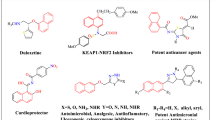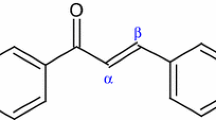Abstract
Diterpenoid alkaloids with remarkable chemical properties and biological activities are frequently found in plants of the genera Aconitum, Delphinium, and Garrya. However, little information has been reported on the antiproliferative effects of the diterpenoid alkaloid constituents of Aconitum and Delphinium plants. C-1 and 14 esterifications of delcosine (1) were carried out to provide 39 new diterpenoid alkaloid derivatives (3–14, 16–29, 3a–7a, 9a, 13a, 13b, 14a, 14b, 16a, 17a, 24a, 35a). Selected compounds (3–14, 16–29, 3a–7a, 9a, 13a, 13b, 14a, 14b, 16a, 17a, 24a, 35a) were evaluated for antiproliferative activity against three to five human tumor cell lines including triple-negative breast cancer (TNBC) and P-glycoprotein (P-gp) overexpressing multidrug-resistant (MDR) subline. Several newly synthesized delcosine derivatives (6, 7, 13, 13a, 13b) showed substantial suppressive effects against all human tumor cell lines tested. In contrast, the natural alkaloids (1, 31, 33) showed no effect. Most of the active compounds were delcosine derivatives with two specific substitution patterns—C-1 and C-1,14. In particular, 1-acyldelcosine derivative (5–7) displayed more potency than 1,14-diacyldelcosine derivatives (5a–7a). These acylated alkaloid derivatives caused accumulation of TNBC cells at sub-G1 within 24 h. 1-Acylation of 1 appears to be critical for producing antiproliferative activity in this alkaloid class and a means to provide promising new leads for further development into antitumor agents.


Similar content being viewed by others
References
Wang FP, Chen QH (2010) The diterpenoid alkaloids. In: Cordell GA (ed) The alkaloids: chemistry and biology, vol 69. Academic Press, San Diego, pp 1–577
Amiya T, Bando H (1988) Aconitum alkaloids. In: Brossi A (ed) The alkaloids, vol 34. Academic Press, San Diego, pp 95–179
Benn MH, Jacyno JM (1983) The toxicology and pharmacology of diterpenoid alkaloids. In: Pelletier SW (ed) Alkaloids: chemical and biological perspectives, vol 1. Wiley-Interscience, New York, pp 153–210
Wada K, Bando H, Amiya T (1985) Two new C20-diterpenoid alkaloids from Aconitum yesoense var. macroyesoense (Nakai) Tamura. Structures of dehydrolucidusculine and N-deethyldehydrolucidusculine. Heterocycles 23:2473–2477
Bando H, Wada K, Amiya T, Kobayashi K, Fujimoto Y, Sakurai T (1987) Studies on Aconitum species. V. Constituents of Aconitum yesoense var. macroyesoense (Nakai) Tamura. Heterocycles 26:2623–2637
Wada K, Bando H, Amiya T (1988) Studies on Aconitum species. VI. Yesoline, a new C20-diterpenoid alkaloids from Aconitum yesoense var. macroyesoense (Nakai) Tamura. Heterocycles 27:1249–1252
Wada K, Bando H, Amiya T, Kawahara N (1989) Studies on Aconitum species. XI. Two new diterpenoid alkaloids from Aconitum yesoense var. macroyesoense (Nakai) Tamura V. Heterocycles 29:2141–2148
Wada K, Bando H, Kawahara N (1990) Studies on Aconitum species. XIII. Two new diterpenoid alkaloids from Aconitum yesoense var. macroyesoense (Nakai) Tamura VI. Heterocycles 31:1081–1088
Wada K, Kawahara N (2009) Diterpenoid and norditerpenoid alkaloids from the roots of Aconitum yesoense var. macroyesoense. Helv Chim Acta 92:629–637
Haveman J, Castro-Kreder N, Rodermond HM, van Bree C, Franken NA, Stalpers LJ, Zdzienicka MZ, Peters GJ (2004) Cellular response of X-ray sensitive hamster mutant cell lines to gemcitabine, cisplatin and 5-fluorouracil. Oncol Rep 12:187–192
Diedelot C, Mirjolet JF, Barberi-Heyob M (2002) Radiation could induce p53-independent and cell cycle-unrelated apoptosis in 5-fluorouracil radiosensitized head and neck carcinoma cells. Can J Physiol Pharmacol 80:638–643
Pauwels B, Korst AEC, Andriessen V, Baay MFD, Pattyn GGO, Lambrechts HAJ, de Pooter CMJ, Lardon F, Vermorken JB (2005) Unraveling the mechanism of radiosensitization by gemcitabine: the role of TP53. Radiat Res 164:642–650
Zhang M, Boyer M, Rivory L, Hong A, Clarke S, Stevens G, Fife K (2004) Radiosensensitization of vinorelbine and gemcitabine in NCL-H460 non-small-cell lung cancer cell. Int J Radiat Oncol Biol Phys 58:353–360
Baumann M, Krause M (2004) Targeting the epidermal growth factor receptor in radiotherapy: radiobiological mechanisms, preclinical and clinical results. Radiother Oncol 72:257–266
Kvols LK (2005) Radiation sensitizers: a selective review of molecules targeting DNA and non-DNA targets. J Nucl Med 46:187S–190S
Sonnemann J, Gekeler V, Ahibrecht K, Brischwein K, Liu C, Bader P, Muller C, Niethammer D, Beck JF (2004) Down-regulation of protein kinase Cη by antisense oligonucleotides sensitises A549 lung cancer cells to vincristine and paclitaxel. Cancer Lett 209:177
Qing C, Jiang C, Zhang JS, Ding J (2001) Induction of apoptosis in human leukemia K-562 and gastric carcinoma SGC-7901 cells by salvicine, a novel anticancer compound. Anticancer Drugs 12:51–56
Meng LH, Zhang JS, Ding J (2001) Salvicine, a novel DNA topoisomerase II inhibitor, exerting its effects by trapping enzyme-DNA cleavage complexes. Biochem Pharmacol 62:733–741
Wada K, Hazawa M, Takahashi K, Mori T, Kawahara N, Kashiwakura I (2007) Inhibitory effects of diterpenoid alkaloids on the growth of A172 human malignant cells. J Nat Prod 70:1854–1858
Hazawa M, Wada K, Takahashi K, Mori T, Kawahara N, Kashiwakura I (2009) Suppressive effects of novel derivatives prepared from Aconitum alkaloids on tumor growth. Invest New Drugs 27:111–119
Hazawa M, Wada K, Takahashi K, Mori T, Kawahara N, Kashiwakura I (2011) Structure–activity relationships between the Aconitum C20-diterpenoid alkaloid derivatives and the growth suppressive activities of non-Hodgkin’s lymphoma Raji cells and human hematopoietic stem/progenitor cells. Invest New Drugs 29:1–8
Wada K, Hazawa M, Takahashi K, Mori T, Kawahara N, Kashiwakura I (2011) Structure–activity relationships and the cytotoxic effects of novel diterpenoid alkaloid derivatives against A549 human lung carcinoma cells. J Nat Med 65:43–49
Wada K, Ohkoshi E, Bastow KF, Morris-Natschke SL, Lee KH (2012) Cytotoxic esterified diterpenoid alkaloid derivatives with increased selectivity against a drug-resistant cancer cell line. Bioorg Med Chem Lett 25:1525–1531
Wada K, Ohkoshi E, Zhao Yu, Goto M, Morris-Natschke SL, Lee KH (2015) Evaluation of Aconitum diterpenoid alkaloids as antiproliferative agents. Bioorg Med Chem Lett 25:1525–1531
Wada K, Ishizuki S, Mori T, Bando H, Murayama M, Kawahara N (1997) Effects of alkaloids from Aconitum yesoense var. macroyesoense on cutaneous blood flow in mice. Biol Pharm Bull 20:978–982
Wada K, Mori T, Kawahara N (2000) Application of liquid chromatography—atmospheric pressure chemical ionization mass spectrometry to the differentiation of stereoisomeric C19-norditerpenoid alkaloids. Chem Pharm Bull 48:660–668
Nakagawa-Goto K, Oda A, Hamel E, Ohkoshi E, Lee KH, Goto M (2015) Development of a novel class of tubulin inhibitor from desmosdumotin B with a hydroxylated bicyclic B-ring. J Med Chem 58:2378–2389
Acknowledgements
We appreciate critical comments, suggestions, and editing of the manuscript by Dr. Susan L. Morris-Natschke (UNC-CH). This study was supported in part by NIH Grant CA177584 from the National Cancer Institute awarded to KHL as well as the Eshelman Institute for Innovation, Chapel Hill, NC, USA awarded to MG.
Author information
Authors and Affiliations
Corresponding author
Additional information
Publisher's Note
Springer Nature remains neutral with regard to jurisdictional claims in published maps and institutional affiliations.
Rights and permissions
About this article
Cite this article
Wada, K., Goto, M., Shimizu, T. et al. Structure–activity relationships and evaluation of esterified diterpenoid alkaloid derivatives as antiproliferative agents. J Nat Med 73, 789–799 (2019). https://doi.org/10.1007/s11418-019-01331-6
Received:
Accepted:
Published:
Issue Date:
DOI: https://doi.org/10.1007/s11418-019-01331-6




